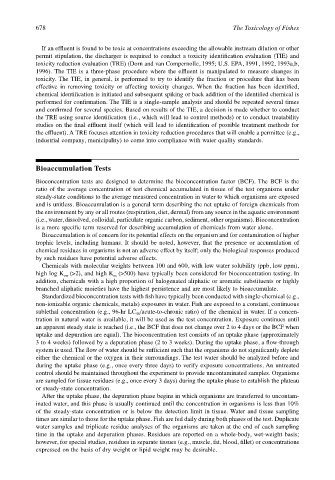Page 698 - The Toxicology of Fishes
P. 698
678 The Toxicology of Fishes
If an effluent is found to be toxic at concentrations exceeding the allowable instream dilution or other
permit stipulation, the discharger is required to conduct a toxicity identification evaluation (TIE) and
toxicity reduction evaluation (TRE) (Dorn and van Compernolle, 1995; U.S. EPA, 1991, 1992, 1993a,b,
1996). The TIE is a three-phase procedure where the effluent is manipulated to measure changes in
toxicity. The TIE, in general, is performed to try to identify the fraction or procedure that has been
effective in removing toxicity or affecting toxicity changes. When the fraction has been identified,
chemical identification is initiated and subsequent spiking or back addition of the identified chemical is
performed for confirmation. The TIE is a single-sample analysis and should be repeated several times
and confirmed for several species. Based on results of the TIE, a decision is made whether to conduct
the TRE using source identification (i.e., which will lead to control methods) or to conduct treatability
studies on the final effluent itself (which will lead to identification of possible treatment methods for
the effluent). A TRE focuses attention in toxicity reduction procedures that will enable a permittee (e.g.,
industrial company, municipality) to come into compliance with water quality standards.
Bioaccumulation Tests
Bioconcentration tests are designed to determine the bioconcentration factor (BCF). The BCF is the
ratio of the average concentration of test chemical accumulated in tissue of the test organisms under
steady-state conditions to the average measured concentration in water to which organisms are exposed
and is unitless. Bioaccumulation is a general term describing the net uptake of foreign chemicals from
the environment by any or all routes (respiration, diet, dermal) from any source in the aquatic environment
(i.e., water, dissolved, colloidal, particulate organic carbon, sediment, other organisms). Bioconcentration
is a more specific term reserved for describing accumulation of chemicals from water alone.
Bioaccumulation is of concern for its potential effects on the organism and for contamination of higher
trophic levels, including humans. It should be noted, however, that the presence or accumulation of
chemical residues in organisms is not an adverse effect by itself; only the biological responses produced
by such residues have potential adverse effects.
Chemicals with molecular weights between 100 and 600, with low water solubility (ppb, low ppm),
high log K (>2), and high K (>500) have typically been considered for bioconcentration testing. In
oc
ow
addition, chemicals with a high proportion of halogenated aliphatic or aromatic substituents or highly
branched aliphatic moieties have the highest persistence and are most likely to bioaccumulate.
Standardized bioconcentration tests with fish have typically been conducted with single-chemical (e.g.,
non-ionizable organic chemicals, metals) exposures in water. Fish are exposed to a constant, continuous
sublethal concentration (e.g., 96-hr LC /acute-to-chronic ratio) of the chemical in water. If a concen-
50
tration in natural water is available, it will be used as the test concentration. Exposure continues until
an apparent steady state is reached (i.e., the BCF that does not change over 2 to 4 days or the BCF when
uptake and depuration are equal). The bioconcentration test consists of an uptake phase (approximately
3 to 4 weeks) followed by a depuration phase (2 to 3 weeks). During the uptake phase, a flow-through
system is used. The flow of water should be sufficient such that the organisms do not significantly deplete
either the chemical or the oxygen in their surroundings. The test water should be analyzed before and
during the uptake phase (e.g., once every three days) to verify exposure concentrations. An untreated
control should be maintained throughout the experiment to provide uncontaminated samples. Organisms
are sampled for tissue residues (e.g., once every 3 days) during the uptake phase to establish the plateau
or steady-state concentration.
After the uptake phase, the depuration phase begins in which organisms are transferred to uncontam-
inated water, and this phase is usually continued until the concentration in organisms is less than 10%
of the steady-state concentration or is below the detection limit in tissue. Water and tissue sampling
times are similar to those for the uptake phase. Fish are fed daily during both phases of the test. Duplicate
water samples and triplicate residue analyses of the organisms are taken at the end of each sampling
time in the uptake and depuration phases. Residues are reported on a whole-body, wet-weight basis;
however, for special studies, residues in separate tissues (e.g., muscle, fat, blood, fillet) or concentrations
expressed on the basis of dry weight or lipid weight may be desirable.

